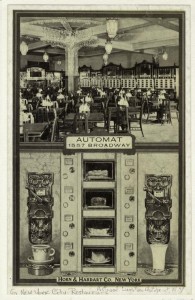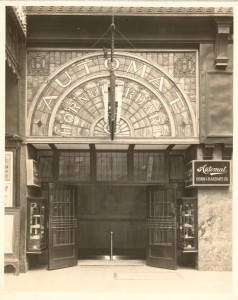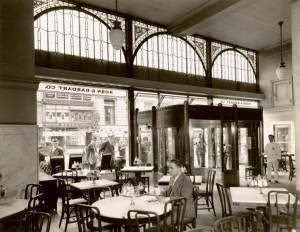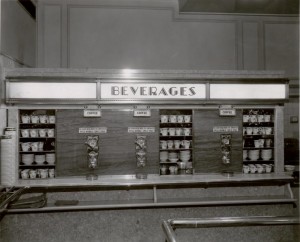In 1912, when Joe Horn and Frank Hardart opened their first New York city automat in the heart of Broadway, New Yorkers were intrigued.
Imagine walking into a restaurant with no waiters, window shopping for your food along a wall of small glass compartments, dropping nickels in a slot next to your choice, turning a knob, lifting the small glass window, and removing what you have selected.
For New Yorkers, young and old, this was a new experience.
Not only was it intriguing, but the food was surprisingly good and the price was right: a nickel for a cup of coffee, one or more nickels for soul food such as macaroni and cheese, creamed spinach, baked beans, cocoanut cream pie, just to name a few. And if you didn’t have enough nickels, not to worry. There was a nickel thrower in a glass booth—-just place a quarter down and with a flip of her five fingers, the nickel thrower would send five nickels at a time down the shoot.
Food for Everyone
Seating was democratic—anyone could sit anywhere at the round tables with their milk glass tops and stay as long as they liked. Rich and poor, social aristocrat, businessman, struggling artists, out of work actors, and just plain working people might sit at the same table even if they didn’t know one another, and they could linger as long as they wanted. Or, if they preferred they could sit alone. Edward Hopper captured this with his 1927 painting of a young woman seated alone at a table at the automat drinking her coffee.
Each table had a lazy Susan with the usual condiments plus Worcestershire Sauce and celery salt. Those who were down and out could make themselves a cup of soup by stirring free ketchup from the lazy Susan into a cup of hot water.
Fast Food Made Fresh
The original “waiterless” restaurant was invented in Switzerland in the 1880s and manufactured in Germany. Joe Horn and Frank Hardart, with the help of their chief engineer perfected it over the years.
Based on their experience in Philadelphia, where they had operated four automats from 1901-1905, Hart and Hardart knew that if they were to succeed, the quality of the food had to be good and the setting attractive. For their first New York automat they commissioned Nicola D’Ascenza, a well known sculptor to create a stained glass window two stories high for the entrance with the word “Automat” at its center. They also commissioned ornate art for the ceiling.
Those who were down and out could make themselves a cup of soup by stirring free ketchup from the lazy Susan into a cup of hot water.
Their secret weapon was their “gilt edge” French drip coffee, which was brewed every 20 minutes. To ensure freshness, it was never allowed to stand more than one hour. When a nickel was dropped in the slot, a precise amount was poured from silver dolphin-head spouts fashioned after a fountain in Italy. In fact, the nickel cup of coffee became so well known that it inspired Irving Berlin to write the song Let’s Have Another Cup of Coffee, which eventually became the unofficial theme song for the automat.

An advertisement shows ornate spigots dispensing precise amounts of fresh coffee, one of the many features for which Horn and Hardarts’ automats became famous. (Photo © New York Public Library)
The quality of the food was not left to chance. It was prepared in a central commissary and shipped to the restaurants. To ensure that it stayed the same day after day, Horn set up a system whereby the food was judged by company executives. At 12:30 p.m. each day, managers from various restaurants and the head chef at the commissary gathered in a specific room with a long wooden table known as the Sample Room. They might be asked to sample several kinds of soup, main dishes, two or three desserts, and even butter if the company were considering changing from one brand to another. If the quality of each item was not up to standard, it was temporarily removed from the menu. The executives often referred to this as the “ulcer table”.
In addition, certain practices were standard: unsold food was never kept overnight to serve the next day, soup was always kept covered to prevent condensation, which would then make it too salty, English muffins were cut with a fork, not a knife, freshly squeezed orange juice, after two hours, was poured down the drain.
By 1920 there were 14 Automats in New York and by 1933 there were 43. Each had its own crowd and became part of the fabric of the community. They were featured in movie scenes and on Broadway; celebrities like Irving Berlin, Veronica Lake, Neil Simon, Gregory Peck, Gene Kelly, columnists like Walter Winchell, and Dorothy Killgalen, were part of the scene, and even the funnies such as Mutt and Jeff and cartoons like Donald Duck included episodes at the automat. And in the movie, Gentlemen Prefer Blondes, Marilyn Monroe sang about it in Diamonds Are A Girl’s Best Friend:
A kiss on the hand may be quite continental, but diamonds are a girl’s best friend.
A kiss may be grand, but it won’t pay the rental, on your humble flat,
Or help you at the automat.

Horn and Hardart commissioned Nicola D’Ascenza, a well-known artist of the time, to create this imposing stained glass window-topped entrance to their first New York City automat. (Photo © New York Public Library)
Following the 1929 market crash, sales increased fifty percent. Rich and famous shared a table with those who didn’t have a job. In 1933 at the height of the Depression, The New York Evening Sun on February 23 had this to say:
“Our Economic Situation in an Eggshell”
Said the Technocrat, to the Plutocrat
To the Autocrat, and the Democrat–
“Let’s all go to the Automat”
The automat had its heyday from 1920 to 1950 but time has a way of bringing about change. The growth of the suburbs, the increasing cost of food, the rise of fast food chains and changing lifestyles all had an impact and the iconic restaurants’ popularity dwindled. The last automat closed in New York City on April 8, 1991. The era of the nickel cup of coffee was over and the restaurants that belonged to rich and poor alike had became a fond memory for those whose life they had touched.


If you are in the New York area, there is a fully restored Automat wall at he NY Public Library until February, 2013. http://exhibitions.nypl.org/lunchhour/exhibits/show/lunchhour
thanks! Love to see the H&H brand lives on with your coffee!
Thanks for the headsup, just tweeted about it. Unfortunately we’re based in Southern California…
How many automata were in Queens Ny and where were they. There is an ongoing debate that I would love to learn the true answer to.